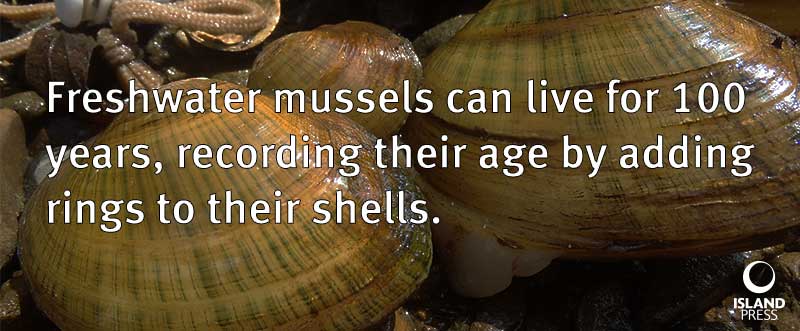Immersion is a breathtaking journey into the world of freshwater mussels. In it, veterinarian and award-winning writer Abbie Gascho Landis explores the hidden lives of mussels in our rivers and streams—and asks whether our capacity to love these alien creatures can power us to protect freshwater for humans and nature alike. Check out nine surprising words that describe freshwater mussels below, and ask any questions you may have about freshwater mussels in the comments.
- Weird. Mussels’ names echo their diverse shell shapes and are equal parts poetry and cartoon. Common names for mussels include the threehorned wartyback, sheepnose, fatmucket, heelsplitter, rabbitsfoot, pistolgrip, pigtoe, monkeyface, and snuffbox.
- Pearly. Each mussel shell glows inside with a pearly lining—pink, white, or purple. Last century, people harvested mussels wholesale to punch circles from their luminous shell lining for use as pearl buttons.

- Unpalatable. In the past mussels fed Native Americans, but people no longer harvest them, perhaps due to a chemical called putrescine (a characteristic of decaying animal tissue) that may affect their flavor.
- Epic. Freshwater mussels can live for 100 years, recording their age by adding rings to their shells, similar to the rings of a tree trunk. They were once called naiades, named for Greek mythology’s water nymphs whose lives were inextricable from their rivers.

- Multitasking. Mussels breathe, eat, and defecate with the same organs—their gills. Those gills help mussels filter water, removing particles to make it cleaner.
- Broody. Female mussel gills have marsupial compartments that brood larval babies. Sealed in these compartments, the larvae are protected from contaminants in the ambient water.

- Deceptive. Mussel larvae must hitch a ride on fish gills to proceed with their lives. Brooding mussels lure fish to their babies by mimicking that fish’s preferred prey with exquisite accuracy—copying a minnow, for example, down to the fin, tail, stripes, and eye-spot.
- Dexterous. After dropping off fish gills, juvenile mussels—the size of sugar crystals—extend a tiny foot from their translucent clamshells to ingest food from the river bottom. As they mature, their gills take over eating, via filtration.
- Imperiled. Nearly 70% of mussel species are in danger, with populations shrinking in damaged rivers. Of roughly 1,000 mussel species in the world, over 180 species are found in Alabama, making it the global hotspot for mussel diversity.


